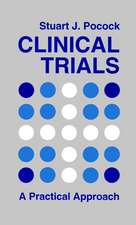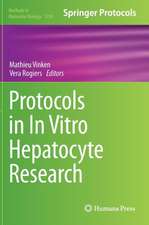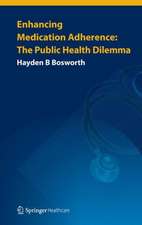Cadmium: Handbook of Experimental Pharmacology, cartea 80
Editat de Ernest C. Foulkes Contribuţii de A. Bernard, A.C. Chang, M.M. El-Amamy, M.D. Enger, J.H. Exon, E. C. Foulkes, K. Fuwa, C.E. Hildebrand, I.S. Jamall, L.D. Koller, S.J. Kopp, R. Lauwerys, K. Matsumoto, K. Nomiyama, A. L. Page, M. Piscator, J C. Seagrave, J. C. Smith, R.A. Tobey, M. Webben Limba Engleză Paperback – 17 noi 2011
Din seria Handbook of Experimental Pharmacology
- 5%
 Preț: 3517.78 lei
Preț: 3517.78 lei - 5%
 Preț: 1425.97 lei
Preț: 1425.97 lei - 5%
 Preț: 1435.28 lei
Preț: 1435.28 lei - 5%
 Preț: 1430.52 lei
Preț: 1430.52 lei - 5%
 Preț: 1930.69 lei
Preț: 1930.69 lei - 5%
 Preț: 1922.47 lei
Preț: 1922.47 lei - 5%
 Preț: 1937.46 lei
Preț: 1937.46 lei - 5%
 Preț: 2117.58 lei
Preț: 2117.58 lei - 5%
 Preț: 2119.96 lei
Preț: 2119.96 lei - 5%
 Preț: 2117.38 lei
Preț: 2117.38 lei - 5%
 Preț: 1088.17 lei
Preț: 1088.17 lei - 5%
 Preț: 1098.27 lei
Preț: 1098.27 lei - 5%
 Preț: 1420.29 lei
Preț: 1420.29 lei - 5%
 Preț: 1104.84 lei
Preț: 1104.84 lei - 5%
 Preț: 1104.84 lei
Preț: 1104.84 lei - 5%
 Preț: 1108.14 lei
Preț: 1108.14 lei - 5%
 Preț: 1106.69 lei
Preț: 1106.69 lei - 5%
 Preț: 1105.77 lei
Preț: 1105.77 lei - 5%
 Preț: 1174.35 lei
Preț: 1174.35 lei - 5%
 Preț: 1432.50 lei
Preț: 1432.50 lei - 5%
 Preț: 408.48 lei
Preț: 408.48 lei - 5%
 Preț: 409.63 lei
Preț: 409.63 lei - 5%
 Preț: 539.90 lei
Preț: 539.90 lei - 5%
 Preț: 720.47 lei
Preț: 720.47 lei - 5%
 Preț: 733.09 lei
Preț: 733.09 lei - 5%
 Preț: 731.27 lei
Preț: 731.27 lei - 5%
 Preț: 746.43 lei
Preț: 746.43 lei - 5%
 Preț: 747.72 lei
Preț: 747.72 lei - 5%
 Preț: 725.24 lei
Preț: 725.24 lei - 5%
 Preț: 742.80 lei
Preț: 742.80 lei - 5%
 Preț: 393.23 lei
Preț: 393.23 lei - 5%
 Preț: 735.66 lei
Preț: 735.66 lei - 5%
 Preț: 728.33 lei
Preț: 728.33 lei - 5%
 Preț: 389.52 lei
Preț: 389.52 lei - 5%
 Preț: 730.71 lei
Preț: 730.71 lei - 5%
 Preț: 740.58 lei
Preț: 740.58 lei - 5%
 Preț: 730.19 lei
Preț: 730.19 lei - 5%
 Preț: 723.42 lei
Preț: 723.42 lei - 5%
 Preț: 731.27 lei
Preț: 731.27 lei - 5%
 Preț: 726.68 lei
Preț: 726.68 lei - 5%
 Preț: 3516.49 lei
Preț: 3516.49 lei - 5%
 Preț: 729.26 lei
Preț: 729.26 lei - 5%
 Preț: 737.11 lei
Preț: 737.11 lei - 5%
 Preț: 730.92 lei
Preț: 730.92 lei - 5%
 Preț: 738.78 lei
Preț: 738.78 lei - 5%
 Preț: 909.94 lei
Preț: 909.94 lei - 5%
 Preț: 720.10 lei
Preț: 720.10 lei - 5%
 Preț: 734.74 lei
Preț: 734.74 lei - 5%
 Preț: 727.80 lei
Preț: 727.80 lei
Preț: 725.79 lei
Preț vechi: 763.99 lei
-5% Nou
Puncte Express: 1089
Preț estimativ în valută:
138.90€ • 144.48$ • 114.67£
138.90€ • 144.48$ • 114.67£
Carte tipărită la comandă
Livrare economică 14-28 aprilie
Preluare comenzi: 021 569.72.76
Specificații
ISBN-13: 9783642708589
ISBN-10: 3642708587
Pagini: 420
Ilustrații: XIV, 400 p.
Dimensiuni: 170 x 244 x 22 mm
Greutate: 0.67 kg
Ediția:Softcover reprint of the original 1st ed. 1986
Editura: Springer Berlin, Heidelberg
Colecția Springer
Seria Handbook of Experimental Pharmacology
Locul publicării:Berlin, Heidelberg, Germany
ISBN-10: 3642708587
Pagini: 420
Ilustrații: XIV, 400 p.
Dimensiuni: 170 x 244 x 22 mm
Greutate: 0.67 kg
Ediția:Softcover reprint of the original 1st ed. 1986
Editura: Springer Berlin, Heidelberg
Colecția Springer
Seria Handbook of Experimental Pharmacology
Locul publicării:Berlin, Heidelberg, Germany
Public țintă
ResearchCuprins
1 The Estimation of Cadmium in Biological Samples.- A. Brief Survey of Cadmium Chemistry.- B. Analytic Methods for Cadmium.- References.- 2 Cadmium in the Environment and its Entry into Terrestrial Food Chain Crops.- A. Introduction.- B. Natural Occurence.- C. World Production.- D. Consumption.- E. Cadmium in Noncontaminated and Contaminated Soils.- F. Phytotoxic Effects of Cadmium.- G. Concentrations of Cadmium in Food Chain Crops.- H. Human Intake of Cadmium.- J. Methods to Control the Entry of Cadmium into Food Chain Crops.- K. Summary.- References.- 3 Absorption of Cadmium.- A. Introduction.- B. Routes of Exposure.- C. Mechanism of Intestinal Cd Absorption.- D. Control of Cd Absorption.- E. Summary.- References.- 4 The Chronic Toxicity of Cadmium: Influence of Environmental and Other Variables.- A. Introduction.- B. Environmental Pollution with Cadmium and Health Effects.- C. Renal Effects.- D. Skeletal Effects of Cadmium.- E. Blood Pressure, Cerebrovascular Disease, and Heart Disease.- F. Recovery from Cadmium-Induced Health Effects.- G. Chemical Forms of Cadmium in Food and Health Effects.- H. Elevated Sensitivity to Cadmium.- J. Metal Shift in Cadmium Intoxication.- K. Biologic Monitoring of Cadmium Exposure.- L. Estimation of Allowable Intake of Cadmium.- References.- 5 Effects of Cadmium Exposure in Humans.- A. Introduction.- B. Human Exposure to Cadmium.- C. Metabolism.- D. Acute Toxicity.- E. Chronic Toxicity.- References.- 6 The Nephropathy of Chronic Cadmium Poisoning.- A. Introduction.- B. Uptake, Storage, and Turnover of Cadmium in the Kidneys.- C. Effects on Tubular Function.- D. Effects on Glomerular Function.- E. Diagnosis.- F. Prognosis.- G. Prevention.- References.- 7 Cadmium and the Cardiovascular System.- A. Preface.- B. Historical Overview.- C. Actions of Cadmium on the Myocardium.- D. Vascular Actions of Cadmium.- E. The Cadmium Hypertension Controversy.- Appendix A.- Appendix B.- References.- 8 Role of Metallothionein in Cadmium Metabolism.- A. Introduction.- B. Historical Background and Chemistry of the Metallothioneins.- C. Determination of Metallothionein Concentrations in Mammalian Tissues.- D. Metallothionein and the Metabolism of Cadmium.- E. Metallothionein Synthesis in Relation to the Chronic Toxicity of Cadmium.- F. Metallothionein Synthesis in Relation to the Acute Toxicity of Cadmium.- G. Kidney Uptake, Metabolism and Toxicity of Exogenous Metallothionein.- H. Function of Metallothionein in the Transport of Cd from the Liver to the Kidney.- J. Normal Functions of Metallothionein and the Interactions of Cd with these Functions.- K. Function of Metallothionein in the Reproductive Toxicology of Cd: Role in Perinatal Development.- L. Metallothionein: A Limiting Factor in the Chelation Therapy of Cd Intoxication.- References.- 9 Immunotoxicity of Cadmium.- A. The Immune System.- B. Immunoassays.- C. Effects of Cadmium on Immune Responses.- D. Summary.- References.- 10 The Effect of Dietary Selenium on Cadmium Cardiotoxicity.- A. Introduction.- B. Cadmium and the Heart.- C. Selenium Deficiency and Cardiomyopathy.- D. Cadmium-Selenium Interactions.- E. Cadmium-Copper Interactions.- F. Cadmium-Metallothionein Studies.- G. Investigations into the Mechanism of Cadmium Cardiotoxicity.- H. Physiologic Studies.- J. Conclusions.- References.- 11 Cellular Resistance to Cadmium.- A. Introduction.- B. Cultured Cell Systems for Studying Cd Metabolism.- C. Role of Metallothionein in Cellular Cd Resistance.- D. Non-Metallothionein Mechanisms of Cellular Cd Resistance.- E. Models Describing Cd Metabolism and the Role ofMetallothionein and Other Factors in Resistance and Sensitivity.- F. Future Directions.- G. Summary.- References.










